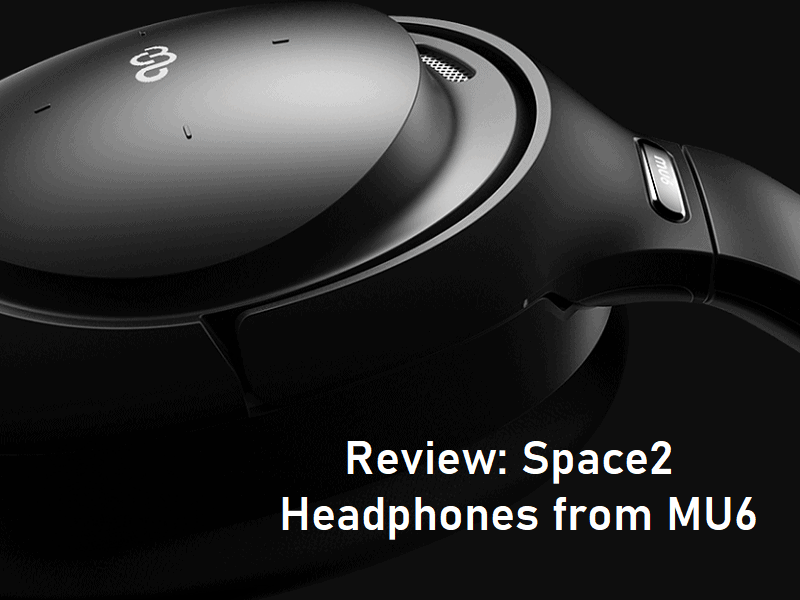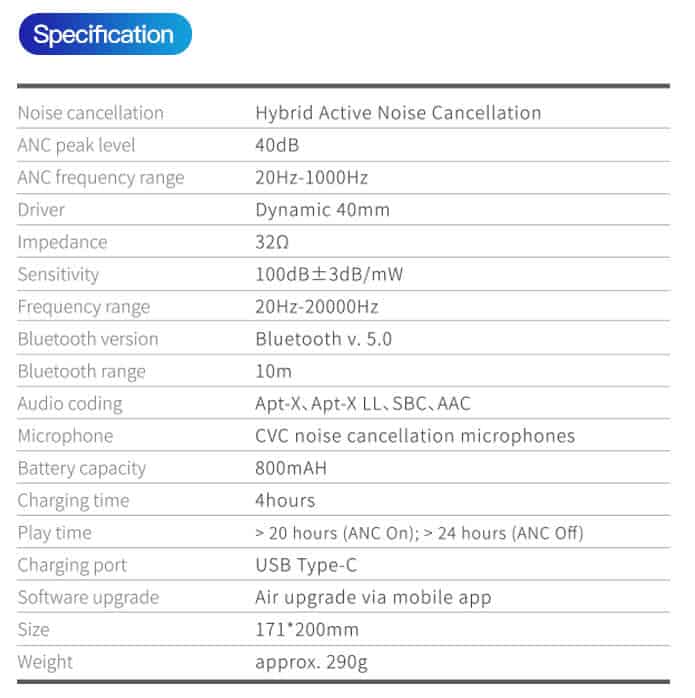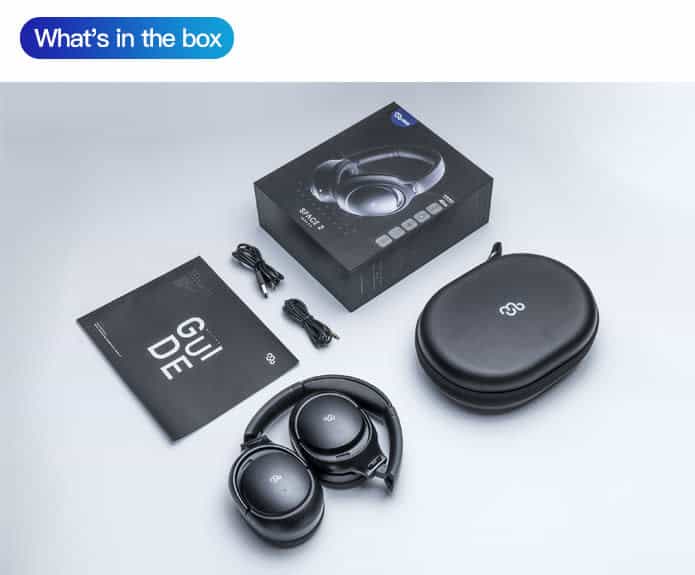In the past, we’ve talked about a previous pair of headphones from MU6 that they had on IndieGoGo. We didn’t get our hands on them to review, unfortunately. This time though, they did send us not only one to look over, but in fact, they sent us TWO to look over. Both mgs2master2 and I have received one for looking over and scrutinizing, so we decided to team up to tackle the whole thing. We even received multiple discount codes for our readers to use. We included both at the bottom. We’re unsure of their expiration dates, so use them while you can. Alright, on with the show!
Trailer:
Specifications:
Features:
- ‘Dual Noise Sensor: Mu6 Space 2 can not only detect external sound but also listen inside your ear by placing a microphone both on the inside and outside of the ear cup. So it can catch and eliminate more noise. Let you hear less noise and focus more.
- Diaphragm with ZrO2 Coating: the dual 40mm dynamic speak drivers package diaphragm with aluminum top which coated with diamond-like hard ZrO2 coating. It is characterized by good rigidity, small distortion, high resolution, which can make the immersive sound.
- Zero Pressure Earcup Design: Enlarging and deepening the earcup will not press on the ears, creating a zero pressure space for your ears.
- Smart Interactive: To adjust the volume, change the song, make a call, simply move your fingertips or say “Hey Siri,” even take off the headphones, because Space 2 be featured with 3D touch, smart touch & talk, voice assistant, auto pause & play functions.
- Easy to Carry: Swivel& folding design make these over-ear wireless active noise-canceling headphones easy to put into your package and take along anywhere.’
Unboxing Video:
V1RACY Pros:
- Portability. Your new headset is pretty dang portable. The part I want to focus on first is the case that it comes with. It isn’t necessarily a hardshell case like Pelican makes. However, you’ll find that it’s thicker and sturdier than a soft case. The inside of it is lined with a smooth surface to protect your headphones further. There is also a partition down the middle that keeps your cups from touching and rubbing against each other. What also adds itself to the portability is how the headset collapses down. Some headphone cases you just lie your headset in the case as is. This one lets the cups swivel inward and fold nicely. This allows for the case to be even smaller and more comfortable to transit.
- Dedicated App. I thought that it was interesting that MU6 had taken the time to make a dedicated app. The app is on the Google Play and App Store. It lets you customize settings for the headphones. This is so that when they’re connected to your smart device, you have universal settings despite what app you’re listening to. This app is designed to work on both their Space1 and Space2 products. On the Space2, you can swap between ANC options, if you want to power off, and auto-pause/play. The autoplay and pause are excellent because if enabled, it uses the sensor in the cup to detect if the headset is being worn. If removed, the headset will pause the music. When the headset is reapplied, then the music will resume. For those who like to experiment, the app also has a reset option if you messed something up, and you’re not quite sure what.
- Sound Quality. We’re definitely not experts on the topic of sound quality. Knowing this, what I set out to do was to put it to the most stringent tests I could find. If it passed, then we know that average, everyday users will get their money’s worth out of it. We also know that people who listen to high definition audio. Meaning no matter what kind of listener you are, if you drop the money on it, will you get the most out of it?
I can make some statements based on what I know as well as what I like and don’t like with audio. The headphones operate at a maximum of 40db. There’s a built-in feature that helps adjust the volume depending on your environment. It has a great, thumping bass that fills the space evenly and doesn’t smack you too hard in the ears. The treble always seems to be a problem as you may be listening to a song that is appropriately mastered than a high pitched Youtuber talking the next moment. The treble is something that I always have to dial in, no matter the headset. However, I barely used this on my iPhone, mostly used it with my older iPod. However, when listening to several things across my phone, I didn’t once have any sudden change in the high pitched treble. Everything was very well balanced, and if anything bothered me was the fact that my volume was up too high to listen to Pewdiepie talk. I also love it when I have headphones that support spacial audio. And while these don’t have Dolby Atmos, I was able to get a very satisfying and useable spatial experience out of them.
I put them to the test in two ways. First, I pushed them to their limits to see what kind of numbers I would get with this video. It was able to test the bass frequency. This headset can push past the audible range for humans. That means that this headset can go just below 20 Hz. The video tested the treble, too, mentioning that good headphones can reproduce frequencies up to 20,000 Hz. The Space2 also dominated in that test as well. It examines the bass drivers, and they did stand up to the test. It tested the stereo capabilities of the headset, which in this day and age, all headsets should be stereo capable. So yeah, it passed that test quickly. It played a binaural audio file to test the spatial capacity. Unfortunately, the file they played was crap (don’t worry, I test it another way in a moment). It tested left, right, and “center” of your headphones at different bass and treble levels, the Space2 passed that. Lastly, there is a hearing test. I think this is more for the listener than the headphone testing. But it starts at 20,000 Hz and works its way down until you hear something, then you make a note of the hertz value that you heard it at. It was in the high 15,000 Hz range.
The way that I tested the spatial capabilities of the headset was with this video. There isn’t much to talk about with it, if your headphones are good, you get a haircut from all sides while some other things happen around you. The Space2 beat out my editing headphones, but to be fair, the headphones are just AKG K77’s, so it’s not hard to do. But with regards to the Space2, I will say that the spatial abilities that it has been the best that I’ve ever heard in a pair of headphones. I need to find a way to get them to work with my PSVR! - Wired. I love that more and more of these wireless Bluetooth headphones are coming with headphone jacks on the bottom of them. The Space2 headset is no exception. You can extend the headphones to be used on even more devices that you love. Maybe they’re legacy devices such as an iPod 6th gen (sorry, guilty pleasure). Perhaps they’re current devices like phones, and you want to keep your phone alive longer by not using the Bluetooth function. It especially lets you extend the listening time of your jam time. If the Space2 didn’t have a headphone jack on them, then I would state that the whole headset is a bust, a straight-up deal breaker.
mgs2master2 Pros:
- Comfort. Comfort feels brilliant overall. The fit over the head is customizable, and no matter what setting you have it at, it maintains a tight hold. The pressure on the ears is firm and helps cancel out sound, but it is still comfortable. You have the right amount of pressure to keep it from sliding and moving forward or backward off of your head. The bar over your head has a leather finish and excellent, soft padding inside. This is always a deal-breaker for me with over-ear headphones. However, the Space2 nails it here!
- Battery Life. In my tests, I found that the battery life lasts 24 hours. Once the battery eventually dies, you can just plug in the auxiliary cord and continue listening if you need to. But 24 hours is a long time for a battery to last. I’d assume that most of you don’t listen for 24 hours a day. You probably don’t even listen for 12 hours a day. But also if you listen 8 hours a day, this charge will give you a few days’ worths of quality.
If you are someone who has the ANC enabled (more on that soon), the music at full blast, the bass on the equalizer set high, the autoplay/pause enabled, you’re probably going to get the advertised 20 hours. If you love music more than features, you can leave all of that off and gain some battery. If you’re someone who wants to enable the features they’ve paid for, then you’ll get about 4 hours less. - Design. The sleek black on black design truly is a fashion statement. You’re buying a headset that matches everything you could wear and doesn’t have strange colors or shape to it. Furthermore, there’s not an overabundance of large or tacky logos on it. No giant scrawling works on the top of the headset. It’s minimal, tasteful, and is excellent for people of all ages. It doesn’t look like it belongs to a teenager, but it isn’t all old school looking for a younger person to pass them up. With all of the rounded edges, the matte finish, and the buttons hidden on the bottom, the Space2 is so sleek and understated. Even the case matches the look! The headset isn’t all looks either. The function is built into this headset as well. The simplicity of how it’s designed in terms of folding it down and fitting into the case also needs recognition.
- ANC. With the Space2, you get different types of active noise cancellation. You can indeed turn it off and just use the thick cups to drown out some of the sounds. But I recommend using either of the other two settings as well, whichever one suits you. The first mode is where ANC is on full blast. With ANC on, it listens to both the inside and outside of your ear to make any sounds and silence them. It is incredible how well it works. You’ll be so used to hearing SOMETHING that hearing nothing might trip you out.
If that’s the case, or if you need to hear something outside of the headset, you can choose Transparency mode. It still cancels out obtuse noises and hums but lets you be able to understand. Were you listening for the oven timer? Maybe the baby crying? Is FedEx going to ring your doorbell any minute? On the train listening for your stop? No matter the reasons, Transparency mode is for you. And as we mentioned before, you can turn all of it off and let the cups mute whatever they can.
Lastly, another quick mode that you can use to give you something similar to Transparency mode is the Smart Touch & Talk. If you’re not expecting to hear something but you see someone is walking up to you, maybe to ask a question, you have options. But perhaps you don’t want to have to press buttons to switch into Transparency or take off the headset. Smart Touch & Talk lets you cover the outside of your right up with your right hand, and it will decrease your volume by twenty percent. It goes further than that by picking up environmental sounds so you can hear them better.
V1RACY Cons:
- Talkative. I just don’t need the woman in my ear. If I push the button to hear the battery life, I should only hear the percentage said to me. I don’t need her to say “Battery life” and then the percentage. She can also simply say “On,” “Off,” “Connected,” “Disconnected,” you know, the bare minimum. I don’t truly need the extra words when I’m trying to relax and listen to something. You don’t have to have the Voice Assistant on by any means, but then you’re just guessing as you press buttons. I would instead it just find a happy medium of saying less rather than nothing.
- Short. My next complaint my be something of an eye roll to some of you. Conversely, some of you may agree 100%. I take issue with the length of the USB-C cord. Yes, I’m grateful that we have USB-C support on the headset. And I’m glad that supplied us with the USB-C cable to charge with. I’m also not complaining about the lack of a USB charger. My complaint is just how short that cord is. It negates having a cable. I had to buy myself a longer one, 3 feet just doesn’t feel long enough to me for any device to charge with. The only upshot is that the headphone charges relatively fast, I didn’t have time it exactly, but it’s somewhere between 3 and 5 hours.
mgs2master2 Cons:
- Touch Controls. We’re not here to tell you that there should not be touch controls. The main complaint here is the execution of the touch controls on the headset. They’re entirely too sensitive to the touch. If it were executed accurately, it would recognize touch that was intended to be a change in the music. Instead, the touch controls on the Space2 overcompensates. Another way to say this is that it is oversensitive to touch and assumes every touch on the right ear cup is a command. Maybe we’re just trying to adjust the cup. Sometimes, you’re trying to feel for the raised bit of plastic that indicates the button. While you’re fumbling around for it, it sparks a reaction from one that you didn’t want. It forces you not to use it at all. Why pay for a feature that is too sensitive, doesn’t work as advertised, and you don’t use? If they’re going to charge for it, it needs to function accordingly. In the meantime, we just used the controls on our phones/iPods to change and pause.
How to Purchase:
We got an exclusive $10 off discount codes for our readers! You can use either “mgs2” or “Hackin10” or “Hackinformer” without the quotes.
Click here to head to their site. They’re featuring the Space2 front and center. You can’t miss it!





